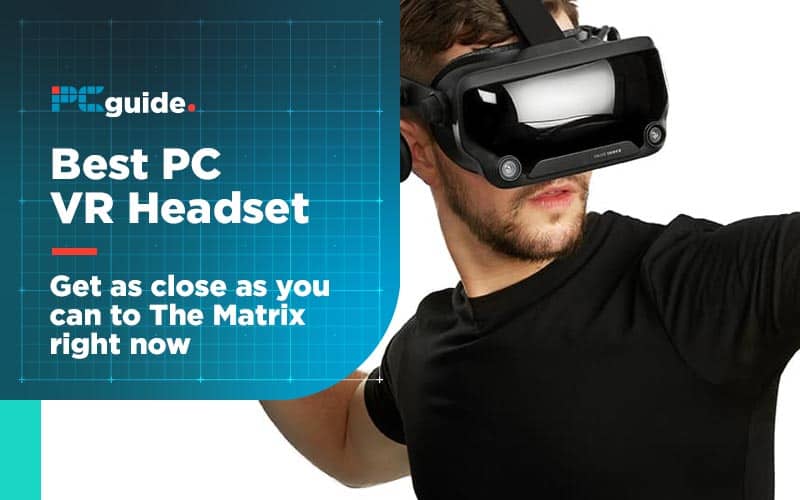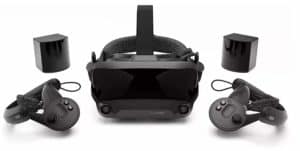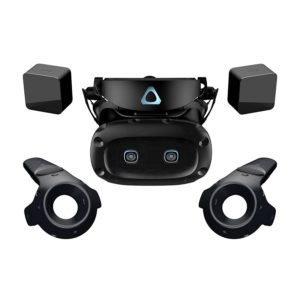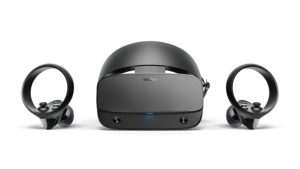Best VR Headset For PC in 2023

Table of Contents
Ask any VR enthusiasts their favorite way to play, and the resounding answer will be on one of the best VR headsets for PC. Standalone VR headsets certainly trump PC VR gaming for convenience and ease of use with an all-in-one package, but at a cost to visual fidelity, performance, and access to games. VR console gaming, more specifically PlayStation VR, grants access to a growing library of exclusives. Still, it’s a closed-off ecosystem with very little flexibility, although the promise of a next-generation virtual reality system for PS5 is worth getting excited about.
As it stands, though, PC VR gaming delivers by far the best experience and the broadest library of games, whether that’s via the Oculus Store, Windows Mixed Reality, or Steam VR. It’s also a great time to jump in with more headset options than ever before, from premium picks like the superb Valve Index to more budget-friendly alternatives like the Oculus Rift S.
So to guide your first steps into PC VR gaming, we’ve pulled together a list of the best VR headsets for PC.
And when you have finished why not check out our:
Products at a Glance
How We Picked
Despite some seismic advances in recent years and concerted efforts from Steam, Facebook, and co. to popularize VR beyond a niche wing of gaming, VR is still expensive. As such, the best VR headsets for PC need to fully justify the hefty price of entry, whether that’s through performance, access to a decent vault of games, or just plain all-round value.
We looked out for headsets that offer a good balance of design, comfort, resolution, field of view, refresh rate, tracking accuracy, controllers, and asking price. Or, in other words, the factors that set headsets apart from one another.
While the number of headsets is by no means extensive compared to other more common gaming peripherals, we still had to make some cuts for the purposes of this guide. As such, we’ve narrowed down our recommendations to five VR headsets for PC. These made the cut for various reasons, which we’ve detailed in a quick review of each below. And, for those that need a little more guidance on what to look out for when it comes to VR headsets for PC, we’ve included a ‘Things to Consider’ section at the end. Let’s dive in.
How we picked
Tracking Sensor System
Outside-In – The traditional VR tracking sensor system. The headset pairs with several base stations, or lighthouses, scattered around the room to track and register player movement and translate it into on-screen action. Outside-In systems tend to deliver more accurate tracking and a more responsive VR experience but take up more physical space and require more setup.
Inside-Out – These systems delegate all the tracking work to the headset with no external base stations required for a convenient, quickly set up all-in-one solution. Accuracy does take a hit. But the difference in tracking accuracy with outside-in tracking systems is more or less negligible for everyone but the most demanding VR enthusiasts.
Resolution, Refresh Rate and FOV
Resolution, refresh rate, and field of view are the most common specifications you’ll encounter when leafing through VR headset product listings. With the eyes so close to the display, resolution dictates not just the quality and detail of the image but also whether you’ll encounter the dreaded screen door effect (SDE), an effect where the small gaps between each pixel, similar to the mesh of a screen door, are visible to the player. The better the resolution, the less likely you are to have the screen door effect, or at least, the less noticeable it will be.
Refresh rate determines how many images or frames the headset can cycle through in any given second. Much like frames per second in traditional PC gaming, the refresh rate dictates whether the experience is smooth or a choppy, stuttering mess that can heighten instances of motion sickness in some players. If possible, we’d suggest aiming for headsets that deliver a 90 Hz refresh rate or higher to be on the safe side, although 80 Hz is respectable at a stretch.
Finally, the field of view is how much of the game is visible to the player through the headset displays. A larger field of view delivers a more immersive experience by revealing more of a game’s world and environment to the player. 100-degree is a good starting point, but if your budget allows, go higher if possible.
PC Specifications
The quality of the VR experience correlates directly to PC specifications. A PC with an Intel i5 Core i5-4590 CPU, NVIDIA GeForce GTX 970, and 8 GB of RAM may technically be sufficient to handle VR, but the experience will be so watered down, not to say choppy, that it’s hardly worth trying. On the other hand, a rig decked out with an AMD Ryzen 9 5900X, NVIDIA GeForce RTX 3090, and 32 GB of RAM will blaze through even the most demanding VR games and deliver a premium, immersive experience. These are, of course, two extremes, but the point is that you’ll need a decent gaming rig to get anything close to respectable VR performance.
We recommend scouting out the system requirements for not just headsets but also a handful of games you plan to play. Doing so should give you a good idea of what PC specifications you’ll need. Lastly, we recommend putting your rig through Steam’s free VR-Ready PC test. A pass all but guarantees a PC is up to the task of running most if not all VR games on Steam.
Product Reviews
- 2880 x 1600 resolution
- 130-degree field of view
- 80/90/120/144 Hz refresh rates
- Best-in-class construction and comfort
- Superb and versatile controllers
- Price
- Requires a high-end gaming PC
- Stock shortages
If we put the roughly $1000 asking price aside, the Valve Index sits unrivaled at the top of the VR headset for PC pyramid. The Index is a masterclass of design, performance, and specifications, fine-tuned to grant player’s the most immersive VR experience among consumer-level headsets.
The specifications alone make the Valve Index a top choice: a resolution of 2880 x 1600 via a pair of canted full RGB displays, a generous 130-degree field of view, and variable refresh rates of 80/90/120 Hz and even an experimental 144 Hz. All these combine to offer a buttery smooth VR experience that’s responsive, sharp, and with a high level of visual fidelity. Tracking is excellent thanks to two Base Stations 2.0 that employ laser tracking that sweeps 100 times per second to register every gesture, motion, and posture.
This best-in-industry approach also extends to the Valve Index ‘Knuckle’ controllers. Decked out with all manner of sensors, including individual finger tracking, the controllers feature all the inputs you’d ever need to bring VR titles to life. The same applies to the construction and quality of the materials used. Comfort is backed into the Valve Index with a perfectly weighted design, antimicrobial fabric, superb off-ear speakers, easy fit adjustments and cleaning, and fine-tuning via IPD and eye relief adjustments.
On the game side of things, Valve’s backing means complete compatibility with Steam VR, and the full Index kit even comes packaged with a free copy of VR’s ‘killer app,’ Half-Life: Alyx.
As we noted above, the Valve Index is among the most expensive VR headsets and does require a high-end PC. If you already have a high-spec gaming rig and want the best VR experience around, then look no further than the Valve Index. High demand and the effects of the pandemic on manufacturing means that sourcing a Valve Index can be difficult due to stock shortages, though.
- 2880 x 1600 resolution
- 90 Hz refresh rate
- 110-degree field of view
- Premium VR experience
- Expensive
With the Valve Index such a dominant force among premium headsets, it’s easy to forget that there are other options out there that, though they may lag behind the Index, are viable alternatives, not least because they are widely available. The best of the rest is the HTC Vive Pro, a premium VR headset with a price tag to match, although the asking price is slightly lower than the Index.
The HTC Vive Pro features a resolution of 2880 x 1600 through high-fidelity AMOLED displays, a perfectly reasonable 90 Hz refresh rate, and an above-average 110-degree field of view. Much like the Index, the HTC Vive Pro employs outside-in tracking via a pair of Steam VR 1.0 base stations for some of the best room-scale tracking performance in the business. HD haptic feedback and 3D spatial audio only heighten the sense of immersion delivered by the Vive Pro.
HTC has gone to lengths to ensure an ergonomic design with a balanced, distributed weight across the headset, which helps raise comfort levels over long sessions. Additionally, adjustable IPD, head strap, and soft padded foam allow the HTC Vive Pro to adapt to most head shapes and sizes. While not quite as versatile as the Index’s, the controllers feature a multi-function trackpad, grip buttons, and a dual-stage trigger for an immersive, hands-on tactile experience.
Much like the Index, the price is the only real drawback, but if your wallet can take the hit and you can’t find an Index, the HTC Vive Pro is the best premium VR headset for PC.
- Value-packed option
- Reasonable asking price
- Inside-out tracking
- 2560 x 1600 resolution
- 110-degree field of view
- 80 Hz refresh rate
- Officially discontinued
Priced at less than half the cost of the Valve Index, the Oculus Rift S oozes value with great specifications, design, and ease of use, a well-rounded option that’s an excellent entry point into the world of VR gaming on PC.
Under the hood, the Oculus Rift S boasts 2560 x 1600 resolution LCDs, a 110-degree field of view, and a slightly under-par 80 Hz refresh rate. Don’t expect the same visual fidelity or immersion as the pricier premium options. Still, the Rift S is a stylish VR headset that delivers a more than decent VR experience.
Where it does trump the premium headsets is in the use of inside-out tracking that removes the fuss of setting up and finding a home for base stations at virtually no cost to tracking accuracy, which is nothing short of stellar. Similarly, the Touch Controllers are arguably better tools than those shipped with the Vive Pro, although they lack the advanced features of the Index ‘Knuckle’ controllers.
Sadly, as of April this year, Facebook has officially discontinued production of the Rift S to make way for the newer Quest 2, warning that any stock replenishment will be sporadic and limited. But, this does mean that the price of Oculus Rift S has been slashed considerably, so if you do find one expect to grab quite the bargain.
Our Verdict

Best VR Headset For PC in 2023
For us, the best VR headset for PC is the Valve Index. Top specifications, superb build quality, full Steam integration, and the best controllers out there are only let down by a hefty price tag.
A close runner-up for those in the market for a premium VR headset, the HTC Vive Pro is an excellent alternative to the Index, especially with stock shortages still an issue in some countries.
For value alone, our pick goes to the Oculus Rift S. An excellent entry-level VR headset with good specifications and an affordable price tag. Pick one up before stocks run out for good, though.
Among WMR-ready headsets, the Samsung HMD Odyssey+ is the most compelling and by a considerable margin. Good specs pair with smooth, crisp visuals, only let down by a slightly high price tag.
Lastly, our budget crown goes to the Acer Windows Mixed Reality Headset. Low cost, functional, if unimpressive, the headset gets the job done despite its flaws.
And with that, we’ll wrap up our guide to the best VR headsets for PC. Don’t hesitate to direct any questions, suggestions, or concerns to the comments section below.



